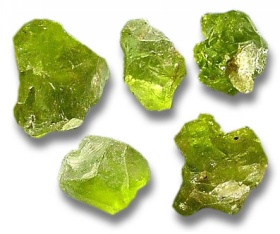Nine out of the ten Biblical translations used in the series translate pitdah in Exodus 28:17 and Ezekiel 28:13 as topaz, while the NLT calls it "a pale green peridot." Other research, however, indicates that this Hebrew word likely refers to a peridot and not a topaz or other precious gemstone.
"The topaz of the ancients was unquestionably the gem commonly called chrysolite at present (olivine, peridot) . . .
"There seems to be little doubt that this is the topazius of ancient writers, which usually signified our chrysolite, or peridot, not our topaz; for Pliny and his successors describe the topazius as a stone of a greenish hue" (Curious Lore of Precious Stones, pages 66, 291).
"True topaz is an aluminum floro silicate and quite hard, but the Old Testament topaz may refer to peridot, a magnesium olivine" (Holman Bible Dictionary).

The view that this breastplate stone is not a topaz is also argued by commentaries such as the IBSE and the Bible Background Commentary. The book "Gemstones in the Breastplate" also makes the case that the second stone in the breastplate is this stone. The book's reasons (among others) for this conclusion is that it has a long history of use as jewelry and were, at one time, valued more than diamonds (page 15).
Given the difficulty to engrave such a hard stone as topaz, it seems likely that the breastplate stone found in the Bible called pitdah is best translated as a peridot gemstone. True topaz, however, was likely used to adorn Lucifer and will be used in the New Jerusalem. According to the mindat.org site, the modern term "chrysolite" is used as a synonym of the olivine. This gemstone only exists in variations of an olive-green color.
Folklore
Peridot, if worn in a setting of gold, was believed to dispel "the terrors" of the night. It could be used as protection against evil spirits and even chase them away (Curious Lore of Precious Stones, page 67).